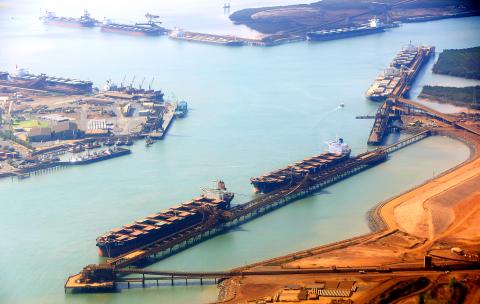Surging mining exports powered the Australian economy to better-than-expected 1.1 percent growth in the first quarter of the year, data showed yesterday, but Australian Treasurer Joe Hockey said he was also encouraged by a pick-up in other sectors.
The figures will come as welcome news for the government as a decade-long mining boom winds down, but analysts warned recent data point to weakness further down the line.
Annual growth was a seasonally adjusted 3.5 percent, the Australian Bureau of Statistics said, compared with analysts’ expectations of 3.1 percent. Markets watchers had expected growth of 0.8 percent in the three months to March.

Photo: Bloomberg
Hockey said while it was clear Australia relied heavily on its mining exports, the expansion in other sectors “show that the expected transition away from mining investment and construction toward other drivers of growth is underway.”
“This is an important indicator that the rest of the economy — the non-mining side of the economy — is starting to lift and that’s encouraging,” he added.
The Australian dollar rose by a third of a US cent to US$92.92 on the back of the figures, which followed a 0.8 percent expansion in the three months to December.
The mining sector made up 80 percent of growth in January to March, as net exports contributed 1.4 percentage points to the final figure. Consumption added 0.3 percentage points, but some of the gains were partially offset by inventories, which subtracted 0.6 percentage points.
Hockey said milder weather at the start of this year played a part in boosting exports.
“It’s an extraordinary quarter in March when you don’t have cyclones, particularly in Western Australia affecting Port Hedland, so our miners are exporting their socks off, and thank God because it’s having a positive impact on our economy,” he said.
However, he cautioned that “one swallow doesn’t make a summer.”
“The fact is that because we didn’t have cyclones in this March quarter, they dug deep into the inventories and as you can see, inventories detracted from the gross national expenditure in this quarter,” Hockey said.
ANZ senior economist Felicity Emmett said while the latest data was “a particularly good result,” it overstated the underlying strength in the economy as more recent data pointed to a slowdown in second-quarter growth.
“That is, retail sales data suggests that household consumption may slow further, while net exports are unlikely to make such a large contribution to growth,” she said. “Moreover, the drag from the wind-back in mining investment is likely to be sharper over coming quarters as large-scale LNG [liquefied natural gas] projects approach completion.”
AMP Capital chief economist Shane Oliver echoed her comments, saying it was “too early to break out the champagne” as he projected growth this quarter of just 0.5 percent.
“Mining export volume growth will slow down after the initial surge from new mine completions, consumer spending is likely to slow on the back of the [last month’s] budget’s short term hit to confidence and the further decline in the iron ore price will weigh on national income,” he said.

MULTIFACETED: A task force has analyzed possible scenarios and created responses to assist domestic industries in dealing with US tariffs, the economics minister said The Executive Yuan is tomorrow to announce countermeasures to US President Donald Trump’s planned reciprocal tariffs, although the details of the plan would not be made public until Monday next week, Minister of Economic Affairs J.W. Kuo (郭智輝) said yesterday. The Cabinet established an economic and trade task force in November last year to deal with US trade and tariff related issues, Kuo told reporters outside the legislature in Taipei. The task force has been analyzing and evaluating all kinds of scenarios to identify suitable responses and determine how best to assist domestic industries in managing the effects of Trump’s tariffs, he

TIGHT-LIPPED: UMC said it had no merger plans at the moment, after Nikkei Asia reported that the firm and GlobalFoundries were considering restarting merger talks United Microelectronics Corp (UMC, 聯電), the world’s No. 4 contract chipmaker, yesterday launched a new US$5 billion 12-inch chip factory in Singapore as part of its latest effort to diversify its manufacturing footprint amid growing geopolitical risks. The new factory, adjacent to UMC’s existing Singapore fab in the Pasir Res Wafer Fab Park, is scheduled to enter volume production next year, utilizing mature 22-nanometer and 28-nanometer process technologies, UMC said in a statement. The company plans to invest US$5 billion during the first phase of the new fab, which would have an installed capacity of 30,000 12-inch wafers per month, it said. The

Taiwan’s official purchasing managers’ index (PMI) last month rose 0.2 percentage points to 54.2, in a second consecutive month of expansion, thanks to front-loading demand intended to avoid potential US tariff hikes, the Chung-Hua Institution for Economic Research (CIER, 中華經濟研究院) said yesterday. While short-term demand appeared robust, uncertainties rose due to US President Donald Trump’s unpredictable trade policy, CIER president Lien Hsien-ming (連賢明) told a news conference in Taipei. Taiwan’s economy this year would be characterized by high-level fluctuations and the volatility would be wilder than most expect, Lien said Demand for electronics, particularly semiconductors, continues to benefit from US technology giants’ effort

‘SWASTICAR’: Tesla CEO Elon Musk’s close association with Donald Trump has prompted opponents to brand him a ‘Nazi’ and resulted in a dramatic drop in sales Demonstrators descended on Tesla Inc dealerships across the US, and in Europe and Canada on Saturday to protest company chief Elon Musk, who has amassed extraordinary power as a top adviser to US President Donald Trump. Waving signs with messages such as “Musk is stealing our money” and “Reclaim our country,” the protests largely took place peacefully following fiery episodes of vandalism on Tesla vehicles, dealerships and other facilities in recent weeks that US officials have denounced as terrorism. Hundreds rallied on Saturday outside the Tesla dealership in Manhattan. Some blasted Musk, the world’s richest man, while others demanded the shuttering of his